Diarrhea is more than a mere inconvenience—it can signal underlying health issues or imbalances within the body. According to Traditional Chinese Medicine (TCM), diarrhea often stems from a deficiency in the spleen, which is responsible for distributing water and nutrients throughout the body. The good news? Acupressure for diarrhea offers a natural and effective way to strengthen the spleen and alleviate symptoms. Applying pressure to specific acupoints can help regulate the digestive system and potentially stop diarrhea at its root cause.
Acupressure Points for Diarrhea
For those who want to get straight to the point, here’s a quick guide on the key pressure points for diarrhea.
- ST-25 – 2 cun lateral to the belly button.
- SP-6 – 3 cun above the medial malleolus on the posterior border of the tibia.
- ST-37 – 3 cun below ST-36, one finger’s breadth away from the tibia’s anterior crest.
- ST-36 – 3 cun below ST-35, one finger’s breadth from the tibia’s anterior crest.
- GV-20 – At the top of the head, 7 cun above the posterior hairline.
- Ren-12 – In the middle of a line connecting the navel and the bottom of the ribcage.
- PC-6 – Three fingers’ width from the center of the wrist crease towards the elbow.
- SP-4 – On the side of the foot, three fingers’ width from the protruding bone next to the big toe towards the heel.
- LI-4 – Where the bones of the index finger and thumb on the back of the hand intersect.
- BL-25 – Position a belt at waist level and secure it with both hands. Keeping the belt at that height, place both thumbs along the spine. The point is generally located approximately two fingers’ width to the outside from this position along the spine.
Acupoint: ST-25 (Other Names: Stomach-25/Tian Shu/Celestial Pivot)
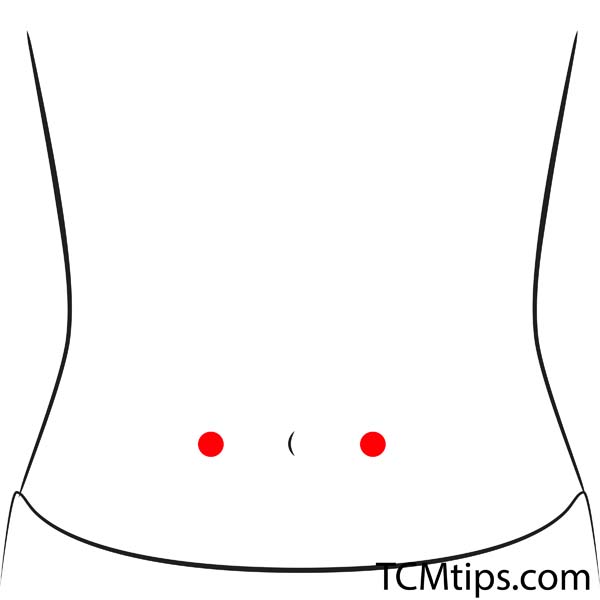

The first acupressure point for diarrhea treatment we will be looking at is the ST-25. The ST-25, also known as the celestial pivot, is located in the middle of the stomach, 2 cun lateral to the belly button or umbilicus.
When activated, the ST-25 helps to regulate the large intestines, spleen, and stomach. They also help in dispelling heat and dampness from the large intestine. ST-25 also helps to resolve blood stasis and qi stagnation.
Massaging the ST-25 clockwise using your index finger can help ease your diarrhea. Other benefits of the ST-25 acupoint include relieving abdominal pain and distention, lateral umbilical pain, constipation, and its use in acupuncture for swollen ankles.
Acupoint: SP-6 (Other Names: Spleen-6/San Yin Jiao/Three Yin Intersection)
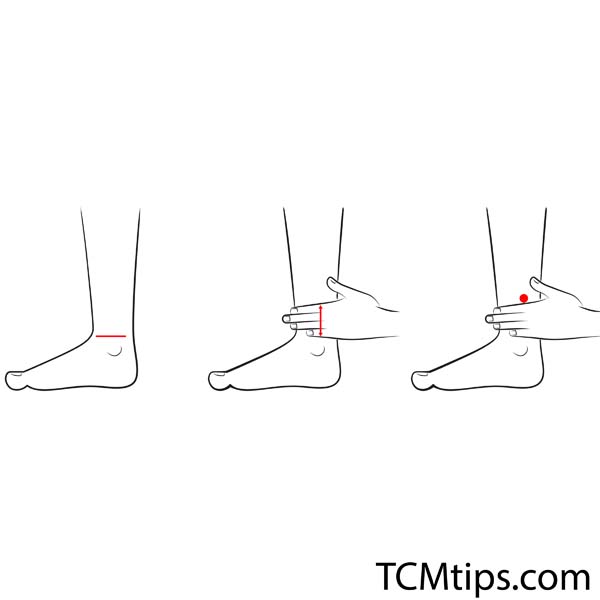
The SP-6 (the spleen-6) is also known as the three yin intersection. This is the junction where the liver, kidney, and spleen meridian cross.
This acupoint has a lot of essential functions, such as strengthening the spleen and restoring balance to the yin, the blood, the kidney, and the liver. In addition, they are responsible for stimulating blood circulation and production, making them good acupressure points for cold hands and feet.
SP-6 also helps resolve the large intestine’s dampness, stomach, and spleen deficiency, diarrhea, paralysis of the foot, and lots more.
It is located 3 cun directly above the medial malleolus, right on the posterior border of the medial aspect of the tibia.
Acupoint: ST-37 (Other Names: Stomach-37/Shang Ju Xu/Upper Great Void)
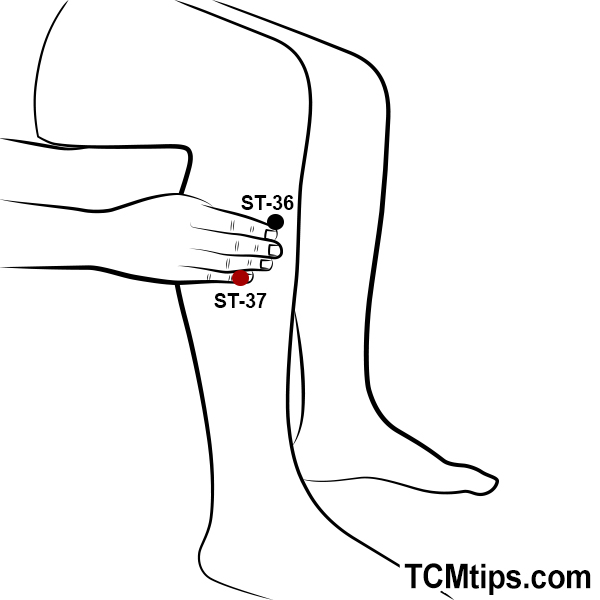
The ST-37 is also known as the Great Upper Hollow. It is one of the best acupoints you can use to carry out self-acupressure for diarrhea treatment.
It is located 3 cun below ST-36, on the anterior part of the lower leg, one finger’s breadth away from the anterior crest of the tibia.
The ST-37 acupoint treats large intestine disorders by regulating its function, dispelling damp-heat, and dispelling food retention.
ST-37 helps alleviate diarrhea and dysentery pains and is a good acupressure point for lower abdominal pain.
Acupoint: ST-36 (Other Names: Stomach-36/Zu San Li/Leg Three Miles)

ST-36, also known as the “three miles of the foot”, is located 3 cun below ST-35, one finger’s breadth from the anterior crest of the tibia.
This is one of the best acupuncture points for diarrhea because, according to traditional Chinese medicine, the ST-36 is the command center of the stomach.
ST-36 helps to harmonize and strengthen the spleen and stomach and also tonifies Qi and blood. It also activates the meridian and stops pain.
Activating this acupoint is effective against stomach pain caused mainly by stress. Place your thumb on the ST-36 acupoint to activate this acupoint for 3 to 5 seconds. Repeat this for 3 to 5 minutes. Also, the ST-36 is a practical acupressure point for colds.
Acupoint: GV-20 (Other Names: The Governing Vessel-20/Bai Hui/Hundred Convergence)
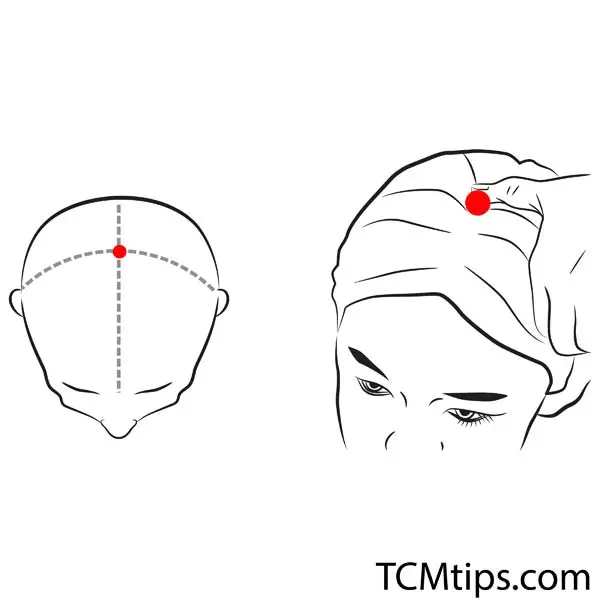
The GV-20, popularly known as the “hundred convergence,” can be located at the top of the head, about 7 cun above the posterior hairline, at the middle of the line connecting both auricles.
This acupoint sits at the crown of the head where all the other yang meridians meet. Traditional Chinese medicine uses the GV-20 to treat psychological problems. For example, performing acupressure on it can help clear the mind, lift spirits, and strengthen the spleen’s ascending function (this helps tackle diarrhea). It is also used in acupuncture for autism.
Acupoint: Ren-12 (Other Names: Conception Vessel-12/Zhong Wan/Middle Epigastrium)

Ms. Mai Sogawa, a senior therapist who graduated from Japan Medical School of Judo Acupuncture and Moxibustion International Education College, recommends Ren-12 (also called CV-12) for cases where the spleen and stomach are weak. This point is located in the middle of a line connecting the navel and the bottom of the ribcage. Applying gentle pressure here can strengthen these organs and offer a natural form of acupressure for diarrhea. The technique involves using gentle pressure for 2-3 seconds, aiming for three times a day.
Acupoint: PC-6 (Other Names: Pericardium-6/Nei Guan/Inner Pass)
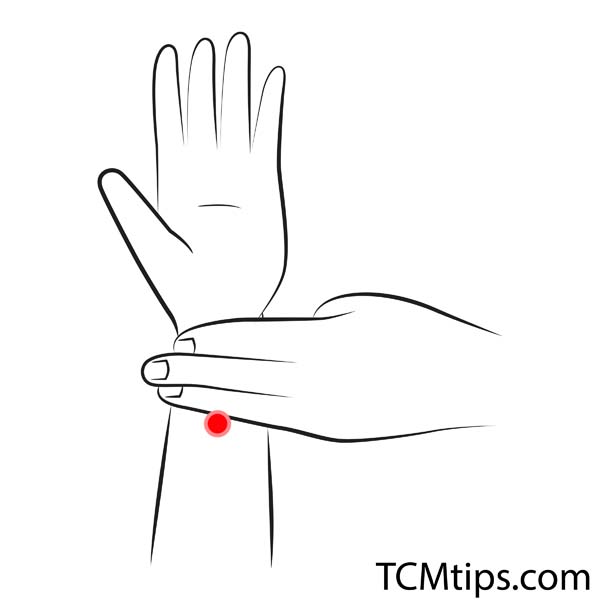
For stress-induced diarrhea, Ms. Mai Sogawa suggests using PC-6. This is one of the hand pressure points for diarrhea. Place your palm facing upward, and measure three fingers’ width from the center of the wrist crease towards the elbow. This hand pressure point for diarrhea is particularly effective for stress-related symptoms. The same technique and frequency as mentioned for CV-12 apply here.
Acupoint: SP-4 (Other Names: Spleen-4/Gong Sun/Grandfather Grandson)

Ms. Mai Sogawa recommends SP-4 for diarrhea caused by overeating. This point is located on the side of the foot, three fingers’ width from the protruding bone next to the big toe towards the heel. Applying pressure to this point can help regulate digestion and alleviate symptoms. The technique and frequency are consistent with the other points.
Acupoint: LI-4 (Other Names: Large Intestine-4/He Gu/Joining Valley)

Ms. Mai Sogawa recommends LI-4 for diarrhea due to accumulated damp heat in the body. This point is located where the bones of the index finger and thumb on the back of the hand intersect. LI-4 is a versatile point that serves the dual function of treating both diarrhea and constipation. The same technique and frequency apply.
Acupoint: Bl-25 (Other Names: Urinary Bladder-25/Da Chang/Large Intestine Transporter)

Ms. Mai Sogawa suggests BL-25 for general diarrhea symptoms. Place your hand on the lower back at a height where the bones are prominent, two fingers’ width away from the spine. This is a key pressure point to stop diarrhea and can be particularly effective when combined with other points. The technique and frequency are the same as for the other points.
Additional Tips: For these specific points—CV-12, PC-6, SP-4, LI-4, and BL-25—Ms. Mai Sogawa suggests that if the underlying cause of your diarrhea is related to coldness, warming the area can enhance the effectiveness of the acupressure treatment. For this purpose, you can use methods like moxibustion, hot towels, heat packs, or even warm showers and baths.
Can Acupuncture Help With Diarrhea?

Acupuncture and acupressure for diarrhea are popular methods in traditional Chinese medicine to treat irritable bowel syndrome (IBS).
Acupuncture might not help cure diarrhea or other gastrointestinal issues at once, but it can help relieve the pain and quicken recovery.
Research published in December 2014 discovered that combining moxibustion and acupuncture significantly reduced patients’ abdominal pain and diarrhea symptoms.
As a standalone procedure, acupuncture demonstrated a 76.7% effective rate in reducing abdominal pain, diarrhea, and bowel movement frequency. This shows that using acupuncture, as well as its counterpart, acupressure for diarrhea is very effective. When combined with moxibustion, the pressure points to stop diarrhea show an effective rate of 96.7%.
In this 2018 study, a network meta-analysis (NMA) was carried out to check the efficacy and possible side effects of acupuncture, pinaverium bromide (with other drugs), and sham acupressure in treating diarrhea-predominant irritable bowel syndrome.
At the end of the network meta-analysis, it was discovered that acupuncture has higher efficacy and the most negligible side effects. It uses acupressure points for IBS with diarrhea, such as ST36, ST25, ST37, GV20, SP6, and EX-HN3.
The study concluded that acupuncture could improve irritable bowel syndrome (IBS) and diarrhea more effectively than drugs with minimal side effects.
Another systematic review and meta-analysis evaluated the safety of acupuncture and its clinical effectiveness in treating diarrhea-predominant irritable bowel syndrome (IBS-D) in adults.
Thirty-one studies involving 3,234 patients were examined, and it was concluded that acupuncture improves the clinical effectiveness of IBS-D or FD.
Can Acupuncture Cause Diarrhea?
Acupuncture and acupressure involve stimulating specific points in the body with either thin needles or by applying pressure. This aims to relieve certain health conditions or symptoms such as pain or soreness.
Different people, especially first-timers, react to acupuncture in different ways. There are specific side effects patients undergoing acupuncture can experience, such as bruising, headaches, emotional release, and even some gastrointestinal issues, such as diarrhea.
People having gastrointestinal issues can suffer from diarrhea when undergoing acupuncture treatment. As an anti-inflammatory treatment, acupuncture helps to alleviate problems such as inflammation and muscle tightness in the digestive tract. When these issues are relieved or eased up, it might lead to diarrhea or feeling nauseous.
When to Avoid Acupressure for Diarrhea
While acupressure can be a highly effective method for treating various symptoms of diarrhea, there are specific conditions where it’s best to avoid this treatment. According to our TCM therapist, Ms. Mai Sogawa, acupressure should be avoided in the following situations:
- Infectious Diseases: If an infectious disease causes your diarrhea, it’s advisable to seek medical treatment rather than relying solely on acupressure.
- Fever or Inflammation: Acupressure may not be suitable if you’re experiencing fever or inflammation, as it could potentially worsen the condition.
- Early Stages of Pregnancy: It’s best to consult a healthcare provider before attempting acupressure for individuals in the early stages of pregnancy.
By being aware of these conditions, you can make a more informed decision about whether acupressure is the proper treatment for your symptoms.
Dual Functionality of Acupressure Points in TCM
In Traditional Chinese Medicine (TCM), some acupressure points serve dual functions, capable of treating both diarrhea and constipation. According to our TCM therapist, Ms. Mai Sogawa, this dual functionality is rooted in the principle of ‘treating different diseases with the same treatment’ (異病同治).
For example, when overeating leads to heat in the stomach and intestines, it can cause blockages in the flow of Qi. This disruption can result in either constipation or diarrhea. In such cases, the same acupressure points—LI-4 (Hegu), ST-25 (Tianshu), SP-6 (Sanyinjiao), and ST-37 (Shangjuxu)—can be effective for treating both conditions.
By understanding this principle, you can better appreciate the versatility and depth of acupressure as a treatment method within the framework of TCM.

Try our Anti-Aging Gua Sha Tool designed to bring out your skin’s natural glow.
Best Gua Sha Product- Anti-Aging: The tool is designed to target 11 specific aging signs such as wrinkles and sagging skin. By following the 7-step routine, users can improve skin firmness and reduce fine lines naturally.
- Enhances Skincare Routine: It works effectively with serums and lotions, boosting absorption and efficacy of skincare products.
- Visible Skin Improvement: Users can expect a smoother complexion, reduced puffiness, and a more youthful appearance.
 P. Sze
P. Sze 

















